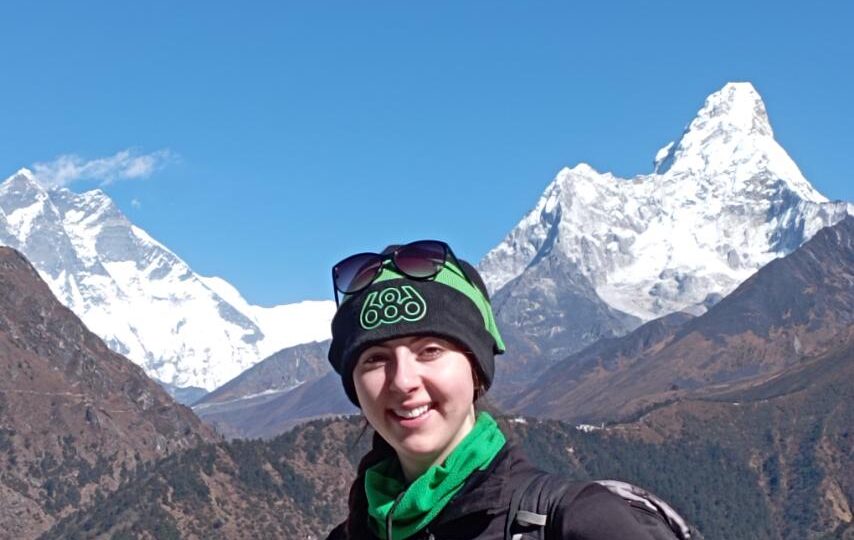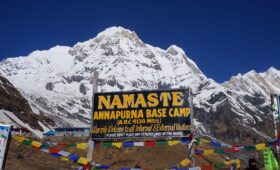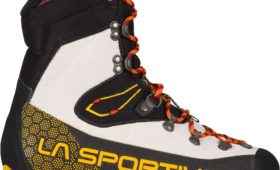Nepal is world famous for its majestic mountains, awesome landscapes, and diverse culture and traditions. This geographical variation offers a number of trekking opportunities throughout the year. And so, trekking in Nepal in January is very much possible.
January is the month where the nature blankets in the world of snow and the whole surrounding turn into the serene peace of heaven. But since January is the local winter month in Nepal you should come prepared for the cold and snow in most of the high altitude trekking trails.
Trekking areas which are in lower altitude are open and are less affected by the cold weather of the winter season.
Trekking in winter has its own distinct advantages. It rarely rains in winter hence you will have clearer skies which ensures you the best views of the mountains.
Since it is an offseason, the trekking routes will be less crowded. You will have the route all to yourself which means you will have quality time to enjoy the views peacefully and take pictures of the mountains.
You will also have less problem with finding accommodation and food. The accommodations are also a lot affordable and with better service. Plus, you do not have to compete for the better room and quality food.
All this make January an ideal month for trekking in Nepal. Lower altitude treks such as Ghorepani Poon Hill Trek and Everest Panorama Treks are a hit. And higher altitude treks such as or the Annapurna Circuit are possible as well.
All you have to do is come prepared with the right clothing, equipment, and mental preparedness for the weather changes.
In order to help you have the best trekking experience in January in Nepal, we will discuss in detail about it below.
Climate and Weather in January
January is the coldest and the driest month of the year in Nepal. The Himalayan region of the country gets freezing cold during this time and the cold wind makes it even colder. It also sees a lot of snowfall during this time.
The average temperature during the daytime is around 8 degree Celsius and during the night time it is around 1 degree Celsius. However, the temperature at Annapurna Base Camp and Everest Base Camp can go below -20 degree Celsius.
Hence, for trekking in higher elevations in Nepal in January you need to be extra prepared. If you are a professional trekker or a climber you will have quite easy time trekking in the cold than the novice trekkers.
You are also advised to take a few extra days in case you face some situations such as flight cancellations etc due to the weather. You will also need to start your trek early because the days are shorter during winters.
Lower elevations treks are much more appropriate in January because it does not get very cold and it does not get snowfalls even in winters.
Even though it can be freezing cold in the mornings and night, the weather is surprisingly pleasant during the day with warm sunlight.
Highlights of Trekking in Nepal in January
- With clear weather almost guaranteed, you will get the best possible views of the mountain ranges.
- Enjoy trekking in the otherwise overcrowded popular trekking trails in peace and solitude.
- Easy access to tea houses and guest houses at cheaper rates.
- Better quality of food and services guaranteed.
Packing Lists for Trekking in January
Toiletries and Personal Hygiene
- Tissue / Toilet roll
- Antibacterial handwash
- Wet wipes
- Soap
- Toothbrush and Toothpaste
- Quick drying towel
- Moisturizer
- Feminine Hygiene products
Clothing
- Thermal Bottoms
- Undergarments
- Fleece or wool pants
- Waterproof shell pants
- T-shirts
- Fleece jacket or pullover
- Fleece Windstopper Jacket
- Waterproof Shell Jacket
- Thermal tops
- Thick insulating Jacket
Head
- Sun hat or scarf
- UV Sunglasses
- Warm beanies
- Earmuffs
Foot and Handwear
- Thin, lightweight inner socks
- Thick, warm hiking socks
- Heavyweight gloves or mittens
- Waterproof shell outer
- Gaiters for hiking in winter
- Hiking boots with spare laces
- Camp shoes (sneakers/sandals)
- Lightweight gloves
General
- Backpack
- Duffel or Rucksack Bag
Accessories
- Sleeping bag rated to zero degrees
- Headlamp
- Water bottles
- Basic First Aid Kit
- Trekking Poles
Recommended Trekking in Nepal in January
Everest Panorama Trek
Maximum Elevation: 3,870 meters
Everest Panorama Trek is the easiest and the safest trek in Nepal during January. As the maximum altitude you will ascend in this trek 3870 meters, the cold of January will not affect you adversely in the trek.
It is this five-seven day trek up to the elevation of 3,870 meters. It is a convenient way to get a taste of the Everest Region.
This trekking route lies in the Khumbu Everest region and the starting point of this trek is from Lukla.
You will take a flight from Kathmandu to Lukla and from Lukla, you will start your trek to Phakding, which takes about 3 hours. From here you will trek to Namche Bazaar, the biggest village in the Khumbu Region.
You will then trek for about 5 hours to reach Tengboche, home to the famous Tengboche Monastery. Tengboche offers breathtaking, panoramic views of the Everest, Lhotse, Ama Dablam and Thamserku.
Along the trek route, you will pass through some beautiful villages and cross some impressive suspension bridges. And thick the and spectacular rhododendron forests are bound to leave you in awe.
Ghorepani Poon Hill Trek
Maximum Elevation: 3,210 meters
The Ghorepani Poon Hill Trek is an extremely popular trek not only amongst foreigners but also the locals. And although Spring is the best time for this trek, January is also equally good. The snow-covered trails and the glistening sunrise views make this trek special in January.
Considered as the most popular destination for best short treks for all season, people usually complete this trek in four to five days. The starting point of this trek is Pokhara and from here you will trek to Tikhedhunga.
From Tikhedhunga you will trek to Ghorepani. This trail will take you across scenic rhododendron and oak forests. You will also get stunning views of some mountains such as Annapurna and Dhaulagiri.
But the main highlight of this trekking route is the view of the Machhapuchhre (Fishtail) which is present beside you throughout the trek.
Ghorepani is a village surrounded by spectacular scenery and is home to the traditionally rich Gurung community.
From Ghorepani, you will head towards Poon Hill at 1,500 feet. This place will provide you with breathtaking views of the snow-capped mountains. The mountains like Dhaulagiri, Annapurna, Fishtail and Singa Chuli etc are spectacular.
The views are especially more breathtaking because of the clear weather of January. You will also enjoy the peace and solitude in the trail which is normally packed with trekkers during the peak seasons.
Khopra Danda Trek
Maximum Elevation: 3,640 meters
Khopra Danda Trek is one of the lesser known trekking destinations as it is a newly opened trekking route in the Annapurna Region. It is usually not packed with trekkers even during the peak season so it is possible for you to have the route all to yourself in January.
So if you are looking for an off beaten trek with solitude, this trek is just for you. Khopra Danda is one of the best viewpoints to get magnificent and panoramic views of Mt. Dhaulagiri, Annapurna I, II, III and south, Hiu Chuli, Fishtail, Lamjung, and Nilgiri.
For this trek, you will follow the same trail as the Ghorepani Poonhill trek. And then descend to a valley before climbing back again to the Khopra Ridge at 3640 m.
Since this trekking route is fairly new, you will get to experience the untouched and raw natural beauty this place has to offer.
Kathmandu Valley Trek
Maximum Elevation: 2,175 meters
Since Kathmandu is at a lower elevation, this trek is the ideal trek in winters. This is a classic 3-day trek that takes you from Kathmandu to Nagarkot and finally to Dhulikhel.
It is a great alternative to those who cannot trek the higher altitudes in winter.
This trek will offer you beautiful views of the Himalayan ranges. And will give you an opportunity to observe the rich and diverse Nepalese culture closely.
You will trek through narrow mountain paths, dense forests, and small villages. The panoramic views of the pristine mountains in the background are absolute bliss.
There are also plenty of other day hikes for you to choose in Kathmandu. Trekking in Kathmandu is easy with a variety of guesthouses and resorts available to choose from.
Few Tips for Trekking in Nepal in January
- Since winters in higher altitudes are harsh, pack clothes and sleeping gears that will protect you from the extreme cold.
- Dress in layers. Even though it is freezing cold in the morning and night, it can get pretty warm during the day when the sun is up. Dressing in layers will help you take off some clothes when it gets hot during the day.
- Wear sturdy trekking boots to protect your feet from the snow.
- Be prepared with proper trekking gears and training prior to trekking in much higher altitudes.
- Always stay hydrated to prevent altitude sickness.
- Keep a few extra days in your itinerary to deal with any unexpected situations like canceled flights due to the weather.
- Always take a guide or porter-guide.
EBC Trek in January general FAQs.
-
What to expect while trekking in January?
Since winter promises clear weather with almost no rainfall, you can expect clear views of the Himalayan ranges. Trekking trails will be less crowded which will help you enjoy the views in peace.
You will have more choices in accommodation at a lesser price. Since the winters are harsher in higher altitudes, be careful of the ice and water on the trail.
-
Will the teahouses and restaurants on the trekking trail be open during winter?
Yes, most teahouses and restaurants in most of the trekking trails will be open even during winters. Especially the ones at the lower altitudes will be open throughout the year.
Conclusion
Trekking in January is enjoyable and safe when you are prepared with proper packing. The dry weather also facilitates trekking in the lower altitudes of Nepal.
The weather in Nepal during January is usually dry and predictable with clear skies. This guarantees you great views of the mountains. You will have clear skies with no rainfall and excellent weather.
Because of fewer people, you will have better choices for accommodation and food. You might even get some discounts from the locals during this time.
And if you are not fond of trekking in extreme cold, you can even enjoy some short treks in lower altitudes of Nepal. You can still get picturesque views of the mountains from the treks at lower altitudes.
If you are planning for trekking in Nepal in January, be well prepared for the cold and possible delays due to the weather. Other than that trekking in January is just as good as the peak seasons.
For further questions and information, please feel free to contact us.
Do you have any question about trip to Nepal?
Tell us about your trip to Nepal and what you expect from it. We will answer your questions in 24 hours and help you design a trip with a comfortable itinerary to best meet your needs.





